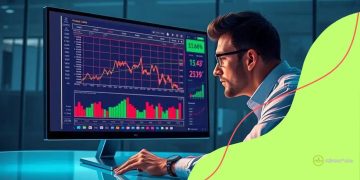Analyzing economic indicators for better decision-making

Analyzing economic indicators like GDP, interest rates, and unemployment rates is crucial for making informed business decisions and understanding market health.
Analyzing economic indicators for informed decisions can significantly impact how we navigate financial landscapes. Ever thought about how these figures shape your investment choices? Let’s dive deeper.
Understanding economic indicators
Understanding economic indicators is vital for anyone looking to make informed financial decisions. These indicators provide key insights into the health and trends of the economy, helping investors and businesses strategize effectively.
Key Economic Indicators
There are several crucial economic indicators that everyone should be aware of. They serve as benchmarks to evaluate the state of the economy and predict future performance.
- Gross Domestic Product (GDP) – Represents the total value of all goods and services produced in a country. It’s an essential measure of economic activity.
- Unemployment Rate – Indicates the percentage of the workforce that is jobless and actively looking for work. This metric helps assess the labor market’s health.
- Consumer Price Index (CPI) – Measures the change in prices paid by consumers for goods and services, serving as a key indicator of inflation.
- Interest Rates – Set by the central bank, they influence borrowing costs and spending in the economy.
As you can see, these indicators are interconnected. Understanding how they influence each other can provide deeper insights into the economic landscape. For instance, rising interest rates often lead to increased borrowing costs, which can slow down consumer spending and impact GDP growth.
Why Are Economic Indicators Important?
Economic indicators help businesses and individuals alike to make wise decisions. By monitoring these metrics, you can adapt your strategies to the current economic conditions. For example, an uptick in the unemployment rate may signal a weakening economy, prompting businesses to adjust their hiring strategies.
Additionally, investors use these indicators to assess market conditions. If the CPI increases significantly, it might indicate rising inflation, prompting investors to consider assets that traditionally hedge against inflation, such as commodities. Recognizing these signals early can result in more informed and timely investment choices.
How interest rates influence economic decisions
Interest rates play a crucial role in shaping economic decisions for both consumers and businesses. When interest rates fluctuate, it can significantly impact spending, saving, and investment behaviors.
The Basics of Interest Rates
Interest rates are the cost of borrowing money. They are set by central banks and can rise or fall based on various economic factors. Higher interest rates generally mean that borrowing becomes more expensive, while lower rates encourage borrowing and spending.
- Impact on Consumer Loans: Higher rates can deter consumers from taking out loans for homes or cars. This can result in reduced sales for businesses dependent on consumer financing.
- Effect on Savings: When interest rates rise, consumers are incentivized to save more. Higher returns on savings accounts can lead to increased deposits.
- Business Investments: For businesses, access to affordable financing is vital. Higher interest rates can lead to postponing or scaling back expansion plans.
Understanding how interest rates function is important for individuals making financial plans. The decision to purchase a home, for example, is heavily influenced by the available mortgage rates. If rates are low, homeowners can lock in favorable terms, making homeownership more accessible.
Economic Growth and Interest Rates
The relationship between interest rates and economic growth is complex. Lower interest rates tend to boost economic growth by encouraging borrowing and spending. Conversely, when rates are increased, it can cool down an overheating economy. Central banks often adjust rates to manage economic fluctuations.
Businesses monitor interest rates closely to make strategic decisions. For instance, if rates are expected to rise, a business might rush to secure funding before costs increase. Understanding this can provide a competitive edge, ensuring that decisions align with economic forecasts.
The role of inflation in investment strategies

The role of inflation in investment strategies is critical for making informed decisions. Inflation affects purchasing power and overall economic stability, influencing how people and businesses invest.
Understanding Inflation
Inflation is the rate at which the general price level of goods and services rises, eroding purchasing power. When inflation increases, each dollar buys fewer goods and services. This can influence individual savings and spending behaviors significantly.
- Types of Inflation: Demand-pull inflation occurs when demand exceeds supply, while cost-push inflation arises from increased production costs.
- Measuring Inflation: The Consumer Price Index (CPI) is a common method used to track inflation. Investors often watch the CPI to gauge trends.
- Impacts on Savings: High inflation can decrease the real value of savings if interest rates on savings accounts do not keep pace with inflation.
Recognizing the implications of inflation is essential for anyone involved in investing. If a person expects inflation to rise, they may choose to invest in assets that tend to provide better returns during inflationary periods.
Adjusting Investment Strategies
Investors often adjust their strategies based on inflation expectations. For instance, assets such as real estate or commodities like gold can be seen as hedges against inflation. These types of investments often maintain or even increase in value when inflation rises.
Moreover, stocks from companies with strong pricing power can also perform well during inflationary periods. These companies can pass increased costs onto consumers without significantly affecting demand for their products.
Analyzing unemployment rates and market health
Analyzing unemployment rates is essential for understanding market health. When unemployment rates rise, it often signals economic trouble, affecting consumer spending and business growth.
What are Unemployment Rates?
Unemployment rates measure the percentage of the labor force that is jobless and actively seeking employment. These rates are often considered a lagging indicator, reflecting the health of the economy.
- Types of Unemployment: There are several types of unemployment, including cyclical, structural, frictional, and seasonal unemployment.
- Impacts on Consumers: High unemployment typically reduces consumer spending, as fewer people have income to spend on goods and services.
- Connecting Unemployment to Economic Growth: A rising unemployment rate can lead to decreased economic activity as businesses pull back on hiring and expansion.
Understanding these types can provide insight into broader economic conditions. For example, during a recession, cyclical unemployment may increase as businesses cut staff due to decreased demand.
Market Health and Unemployment
The relationship between unemployment and market health is significant. When unemployment is low, it usually indicates a robust economy with strong consumer confidence. Conversely, high unemployment can lead to a sluggish economy.
Investors closely analyze unemployment data because it can influence market trends. If a report shows rising unemployment, it may lead to concerns about future economic growth, impacting stock prices.
Additionally, central banks monitor unemployment rates to assess when to adjust interest rates. High unemployment may prompt them to lower rates to stimulate growth, while low rates might lead the banks to raise interest rates to curb inflation.
Using GDP data for business forecasting
Using GDP data for business forecasting is crucial for understanding economic trends. By analyzing GDP, businesses can make informed predictions about future growth and market conditions.
What is GDP?
Gross Domestic Product (GDP) measures the total value of all goods and services produced in a country over a specific period. It serves as a broad indicator of an economy’s health.
- Components of GDP: GDP includes consumption, investment, government spending, and net exports. Each of these components can impact business strategies.
- Real vs. Nominal GDP: Real GDP is adjusted for inflation, giving a more accurate picture of economic growth. This is essential for businesses to consider.
- GDP Growth Rate: Monitoring the growth rate helps businesses gauge the economy’s direction, facilitating strategic planning and budgeting.
Businesses can utilize GDP data to identify patterns and adjust accordingly. For instance, if GDP growth is slowing, a business might consider cutting costs, reducing inventory, or delaying expansion plans until conditions improve.
Forecasting with GDP Data
Forecasting using GDP data involves analyzing current economic conditions and predicting future trends. This process helps businesses prepare for potential challenges and opportunities. Companies typically examine past GDP data along with other economic indicators.
By combining GDP data with unemployment rates and inflation figures, businesses can gain a clearer understanding of the economic landscape. This multifaceted approach allows for more accurate forecasting, which is essential for making smart investment decisions.
Furthermore, businesses can benchmark their performance against GDP growth. If a company is growing faster than GDP, it may indicate it is gaining market share, while slower growth could suggest the opposite.
In conclusion, understanding economic indicators such as GDP, interest rates, and unemployment rates can greatly enhance decision-making for both individuals and businesses. By analyzing these indicators, one can better navigate the complexities of the economy and make informed choices. The insights gained from these metrics not only help in assessing current market conditions but also play a crucial role in formulating future strategies. Staying updated on these trends fosters a more resilient approach to economic changes and opportunities.
FAQ – Frequently Asked Questions about Economic Indicators and Business Decisions
What is GDP and why is it important for businesses?
GDP, or Gross Domestic Product, measures the total economic output of a country. It’s important for businesses because it helps predict market trends and overall economic health.
How do interest rates impact consumer behavior?
Interest rates affect borrowing costs; when rates are high, consumers are less likely to take out loans, which can decrease spending on goods and services.
What does a rising unemployment rate signify?
A rising unemployment rate typically indicates economic trouble, which can lead to decreased consumer spending and slower economic growth.
Why should businesses monitor economic indicators?
Monitoring economic indicators helps businesses make informed decisions, adapt to changing market conditions, and strategically plan for the future.





